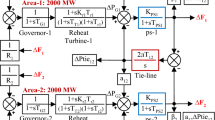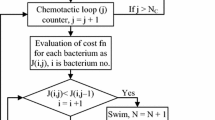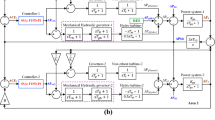Abstract
Owing to nonlinear structure and uncertain load demand characteristics, expert and intelligent automatic generation control (AGC) is inevitable for coherent operation and control of electric power system. Hence, in this paper, to mitigate the frequency and power deviations efficiently under sudden load demand conditions, a novel fractional-order fuzzy PID (FOFPID) controller is suggested in AGC of restructured multi-area multi-source hydrothermal power systems. The parameters of FOFPID controller are optimized by utilizing bacterial foraging optimization algorithm. The controller is implemented on restructured two- and three-area systems. It is observed that the advocated method shows superiority over fuzzy PID, fractional-order PID and conventional PID control schemes. Energy storage units such as redox flow batteries (RFB) which show extremely long charge–discharge life cycle and outstanding quick response to alleviate the system oscillations under disturbances have further been incorporated into the studied systems to analyze their efficacy in boosting AGC performance. Analysis of results reveals that with RFB, system transient performance improves significantly. It is also observed that the obtained results satiate the AGC requirement under different power transactions taking place in a deregulated market in the presence/absence of appropriate generation rate constraint treated for thermal and hydro plants. Finally, the robustness of the presented approach is demonstrated against the wide variations in the system parameters and initial loading condition.












Similar content being viewed by others
References
Chidambaram IA, Paramasivam B (2012) Control performance standards based load-frequency controller considering redox flow batteries coordinate with interline power flow controller. J Power Sour 219:292–304
Chidambaram IA, Paramasivam B (2013) Optimized load-frequency simulation in restructured power system with redox flow batteries and interline power flow controller. Int J Electr Power Energy Syst 50:9–24
Selvaraju RK, Somaskandan G (2016) Impact of energy storage units on load frequency control of deregulated power systems. Energy 97:214–228
Shankar R, Chatterjee K, Bhushan R (2016) Impact of energy storage system on load frequency control for diverse sources of interconnected power system in deregulated power environment. Int J Electr Power Energy Syst 79:11–26
Arya Y, Kumar N (2016) Optimal AGC with redox flow batteries in multi-area restructured power systems. Eng Sci Technol Int J 19(3):1145–1159
Gorripotu TS, Sahu RK, Panda S (2015) AGC of a multi-area power system under deregulated environment using redox flow batteries and interline power flow controller. Eng Sci Technol Int J 18(4):555–578
Arya Y (2017) AGC performance enrichment of multi-source hydrothermal gas power systems using new optimized FOFPID controller and redox flow batteries. Energy 127:704–715
Arya Y, Kumar N (2017) BFOA-scaled fractional order fuzzy PID controller applied to AGC of multi-area multi-source electric power generating systems. Swarm Evol Comput 32:202–218
Nanda J, Mishra S, Saikia LC (2009) Maiden application of bacterial foraging-based optimization technique in multiarea automatic generation control. IEEE Trans Power Syst 24(2):602–609
Ali ES, Abd-Elazim SM (2013) BFOA based design of PID controller for two area load frequency control with nonlinearities. Int J Electr Power Energy Syst 51:224–231
Arya Y, Kumar N (2016) Design and analysis of BFOA-optimized fuzzy PI/PID controller for AGC of multi-area traditional/restructured electrical power systems. Soft Comput. doi:10.1007/s00500-016-2202-2
Sahu RK, Panda S, Padhan S (2015) A hybrid firefly algorithm and pattern search technique for automatic generation control of multi area power systems. Int J Elect Power Energy Syst 64:9–23
Abdelaziz AY, Ali ES (2015) Cuckoo search algorithm based load frequency controller design for nonlinear interconnected power system. Int J Electr Power Energy Syst 73:632–643
Abd-Elazim SM, Ali ES (2016) Load frequency controller design via BAT algorithm for nonlinear interconnected power system. Int J Electr Power Energy Syst 77:166–177
Abd-Elazim SM, Ali ES (2016) Load frequency controller design of a two-area system composing of PV grid and thermal generator via firefly algorithm. Neural Comput Appl. doi:10.1007/s00521-016-2668-y
Jagatheesan K, Anand B, Samanta S, Dey N, Santhi V, Ashour AS, Balas VE (2016) Application of flower pollination algorithm in load frequency control of multi-area interconnected power system with nonlinearity. Neural Comput Appl. doi:10.1007/s00521-016-2361-1
Pappachen A, Fathima AP (2015) BFOA based FOPID controller for multi area AGC system with capacitive energy storage. Int J Electr Eng Inf 7(3):429–442
Zamani A, Barakati SM, Yousofi-Darmian S (2016) Design of a fractional order PID controller using GBMO algorithm for load-frequency control with governor saturation consideration. ISA Trans 64:56–66
Dahiya P, Sharma V, Naresh R (2015) Solution approach to automatic generation control problem using hybridized gravitational search algorithm optimized PID and FOPID controllers. Adv Electr Comput Eng 15(2):23–34
Morsali J, Zare K, Hagh MT (2017) Applying fractional order PID to design TCSC-based damping controller in coordination with automatic generation control of interconnected multi-source power system. Eng Sci Technol Int J 20(1):1–17
Pan I, Das S (2016) Fractional order AGC for distributed energy resources using robust optimization. IEEE Trans Smart Grid 7(5):2175–2186
Pan I, Das S (2016) Fractional order fuzzy control of hybrid power system with renewable generation using chaotic PSO. ISA Trans 62:19–29
Kumar N, Tyagi B, Kumar V (2016) Deregulated multiarea AGC scheme using BBBC-FOPID controller. Arab J Sci Eng 42(7):2641–2649
Debbarma S, Saikia LC, Sinha N (2013) AGC of a multi-area thermal system under deregulated environment using a non-integer controller. Electr Power Syst Res 95:175–183
Kondratenko YP, Al Zubi EYM (2009) The Optimisation approach for increasing efficiency of digital fuzzy controllers. In: Annals of DAAAM for 2009 & Proceedings of the 20th international DAAAM symposium on intelligent manufacturing and automation, Published by DAAAM International, Vienna, Austria, pp 1589–1591
Kondratenko YP, Klymenko LP, Al Zu’bi EYM (2013) Structural optimization of fuzzy systems’ rules base and aggregation models. Kybernetes 42(5):831–843
Bhateshvar YK, Mathur HD, Siguerdidjane H, Bhanot S (2015) Frequency stabilization for multi-area thermal-hydro power system using genetic algorithm-optimized fuzzy logic controller in deregulated environment. Electr Power Compon Syst 43(2):146–156
Shayeghi H, Shayanfar HA, Jalili A (2006) Multi-stage fuzzy PID power system automatic generation controller in deregulated environments. Energy Convers Manag 47(18–19):2829–2845
Donde V, Pai MA, Hiskens IA (2001) Simulation and optimization in an AGC system after deregulation. IEEE Trans Power Syst 16(3):481–489
Arya Y, Kumar N, Nasiruddin I (2016) AGC of a two-area multi-source power system interconnected via AC/DC parallel links under restructured power environment. Optim Control Appl Methods 37(4):590–607
Arya Y, Kumar N (2016) AGC of a multi-area multi-source hydrothermal power system interconnected via AC/DC parallel links under deregulated environment. Int J Electr Power Energy Syst 75:127–138
Sahu RK, Panda S, Yegireddy NK (2014) A novel hybrid DEPS optimized fuzzy PI/PID controller for load frequency control of multi-area interconnected power systems. J Process Control 24(10):1596–1608
Sekhar GTC, Sahu RK, Baliarsingh AK, Panda S (2016) Load frequency control of power system under deregulated environment using optimal firefly algorithm. Int J Electr Power Energy Syst 74:195–211
Alotto P, Guarnieri M, Moro F (2014) Redox flow batteries for the storage of renewable energy: a review. Renew Sustain Energy Rev 29:325–335
Lucas A, Chondrogiannis S (2016) Smart grid energy storage controller for frequency regulation and peak shaving, using a vanadium redox flow battery. Int J Electr Power Energy Syst 80:26–36
Oustaloup A, Levron F, Matthieu B, Nanot FM (2000) Frequency-band complex noninteger differentiator: characterization and synthesis. IEEE Trans Circuits Syst I Fundam Theory Appl 47:25–39
Podlubny I (1999) Fractional-order systems and PIλDμ-controllers. IEEE Trans Autom Control 44(1):208–214
Alomoush MI (2010) Load frequency control and automatic generation control using fractional-order controllers. J Electr Eng 91(7):357–368
Mousavi Y, Alfi A (2015) A memetic algorithm applied to trajectory control by tuning of fractional order proportional-integral-derivative controllers. Appl Soft Comput 36:599–617
Azarmi R, Tavakoli-Kakhki M, Sedigh AK, Fatehi A (2015) Analytical design of fractional order PID controllers based on the fractional set-point weighted structure: case study in twin rotor helicopter. Mechatronics 31:222–233
Zhong J, Li L (2015) Tuning fractional-order PIλDμ controllers for a solid-core magnetic bearing system. IEEE Trans Control Syst Technol 23(4):1648–1656
Zeng G-Q, Chen J, Dai Y-X, Li L-M, Zheng C-W, Chen M-R (2015) Design of fractional order PID controller for automatic regulator voltage system based on multi-objective extremal optimization. Neurocomputing 160:173–184
Liu L, Pan F, Xue D (2015) Variable-order fuzzy fractional PID controller. ISA Trans 55:227–233
Mishra P, Kumar V, Rana KPS (2015) A fractional order fuzzy PID controller for binary distillation column control. Expert Syst Appl 42(22):8533–8549
Sharma R, Rana KPS, Kumar V (2014) Performance analysis of fractional order fuzzy PID controllers applied to a robotic manipulator. Expert Syst Appl 41(9):4274–4289
Passino KM (2002) Biomimicry of bacterial foraging for distributed optimization and control. IEEE Control Syst 22(3):52–67
Nanda J, Mangla A (2004) Automatic generation control of an interconnected hydro-thermal system using conventional integral and fuzzy logic controller. In: Proceedings IEEE international conference on electric utility deregulation, restructuring power technologies 1:372–377
Author information
Authors and Affiliations
Corresponding author
Ethics declarations
Conflict of interest
The author declares that conflict of interest does not exist in his case.
Human participants and/or animals
This research is not related to the involvement of human and/or animals.
Appendices
Appendix 1: Nomenclature and system data [4, 9, 11]
F 0 | 60 Hz; nominal system frequency | K RFB | 1.8; gain of RFB |
R | R1 = 2 Hz/puMW, R2 = 2.4 Hz/puMW; speed governor regulation parameter | T d | 0 s; time delay constant of RFB |
B | 0.425 (= β); frequency bias constant | ∆Pg | Incremental change in area power generation |
K PS | 100; power system gain | ∆PG | Incremental change in GENCO output |
T PS | 20 s; power system time constant | p | Number of parameters to be optimized |
T G | 0.08 s; speed governor time constant | S | Number of bacteria |
T T | 0.3 s; thermal turbine time constant | N S | Swimming length after which tumbling of bacteria will be carry out in a chemotactic loop |
T RH | 48.7 s; hydro turbine speed governor transient droop time constant | N C | Number of iterations to be undertaken in a chemotactic loop (NC > NS) |
T R | 5 s; hydro turbine speed governor reset time | N re | Maximum number of reproduction to be carry out |
T GH | 0.513 s; hydro turbine speed governor main servo time constant | N ed | Maximum number of elimination–dispersal events |
T W | 1 s; water starting time constant | P ed | Probability with which elimination–dispersal will go on |
T12, T13 | 0.0707 puMW/rad; synchronizing coefficient | K 1 | Proportional input scaling factor gain of fuzzy controller |
cpfij | Contract participation factor of jth DISCO with ith GENCO | K 2 | Derivative input scaling factor gain of fuzzy controller |
∆PD | Incremental change in load power demand in an area | γ | Order of input derivative of fuzzy controller |
∆PUC | Incremental change in uncontracted load power demanded by DISCO | K P | Proportional gain of controller |
∆F | Incremental change in the area frequency | K I | Integral gain of controller |
∆PC | Incremental change in the speed changer position | K D | Derivative gain of controller |
K r | 0; reset gain of RFB | λ | Order of output integrator of fuzzy controller |
Tr | 0 s; reset time constant of RFB | μ | Order of output derivative of fuzzy controller |
Appendix 2
2.1 Justification for the choice of number and types of membership functions
Firstly, for the justification of employing 5 membership functions (mfs), a comparative study is carried out using 3, 5 and 7 mfs in FOFPID controller for AGC of two-area restructured power system with RFB considering poolco-based transactions. Identical mfs are used for inputs and output and in both areas of the system having nominal horizontal range of mfs [−1, 1]. The parameters of FOFPID are optimized via BFOA for 3 and 7 mfs. Figure 12a incorporates ∆F1 response with 3, 5 and 7 mfs. From the analysis of Fig. 12a, it is evident that ∆F1 response indicates better dynamic performance in terms of lesser undershoot and settling time with 5 mfs compared to 3 and 7 mfs. The undershoot with 3 mfs is more than that of 5 mfs and worst with 7 mfs. However, settling time is better with 7 mfs in comparison with 3 mfs. The findings are analogous to the findings of [47]. Hence, the overall performance of 5 mfs is superior to 3 or 7 mfs, which makes 5 mfs a very effective choice in AGC study of restructured multi-source hydrothermal power systems.
To justify the choice of selecting triangular mfs in the current study, the simulations are also carried out with trapezoidal and Gaussian mfs. Three-area restructured multi-source hydrothermal power system without RFB is simulated for poolco-based transactions with FOFPID controller using trapezoidal and Gaussian mfs. FOFPID controller is again optimized with trapezoidal and Gaussian mfs by means of BFOA. It should be noted that identical trapezoidal and Gaussian mfs are used for both inputs and one output for all areas of the system under study with nominal horizontal range of mfs [−1, 1]. Figure 12b includes ∆F1 response with triangular, trapezoidal and Gaussian mfs. From the scrutiny of Fig. 12b, it is apparent that ∆F1 response is the best with triangular mfs [28]. With triangular mfs, result shows lesser undershoot, overshoot and settling time as well as faster response. The response with trapezoidal mfs shows larger overshoot and undershoot, but settling time is very much competitive with triangular mfs. The result with Gaussian mfs demonstrates higher undershoot, lower overshoot and larger settling time compared to trapezoidal mfs. Hence, it can be concluded that the best choice of mfs is triangular for AGC studies of multi-area restructured power systems.
Rights and permissions
About this article
Cite this article
Arya, Y. AGC of restructured multi-area multi-source hydrothermal power systems incorporating energy storage units via optimal fractional-order fuzzy PID controller. Neural Comput & Applic 31, 851–872 (2019). https://doi.org/10.1007/s00521-017-3114-5
Received:
Accepted:
Published:
Issue Date:
DOI: https://doi.org/10.1007/s00521-017-3114-5





